Camping season is coming quickly in many states, and it’ll soon be time to dewinterize your RV. Dewinterizing your RV means getting your RV out of RV storage, inspecting it and preparing all the mechanics for camping.
If this is your first time dewinterizing your RV, you’ve come to the right place. We asked our RV experts everything you need to know about prepping your RV for another season of making memories!
When Should I Dewinterize My RV?
You want to dewinterize an RV when the weather consistently stays above freezing. If the temperature is still inconsistent, you risk having your pipes freeze. Just like a house, if your pipes freeze and you have water in your tanks, it could damage your RV’s water systems and lead to expensive repairs.
Dewinterizing an RV can take half a day or longer depending on how many systems you have. Prepare your time wisely, and don’t be afraid to seek professional RV service for dewinterization. RV experts are here to help you start the camping season smoothly.
Just remember that all RVs are different, so this is a general overview of how to dewinterize an RV. Not all steps may apply to your RV. Read your owner’s manual before getting started for model-specific RV dewinterizing instructions.
Step By Step Instructions For Dewinterizing Your RV and Preparing For Camping Season
Remove Your RV From Storage And Inspect The Exterior

Take your RV cover off or remove any debris that may be on your RV. Thoroughly check the exterior for any signs of damage from the weather. Look for any damages, cracks or leaks on the whole exterior of your RV. Make sure the caulk isn’t cracked along the seams of your RV. Replace any sealant that is damaged to ensure water does not enter your RV.
Look Over Your RV Tires
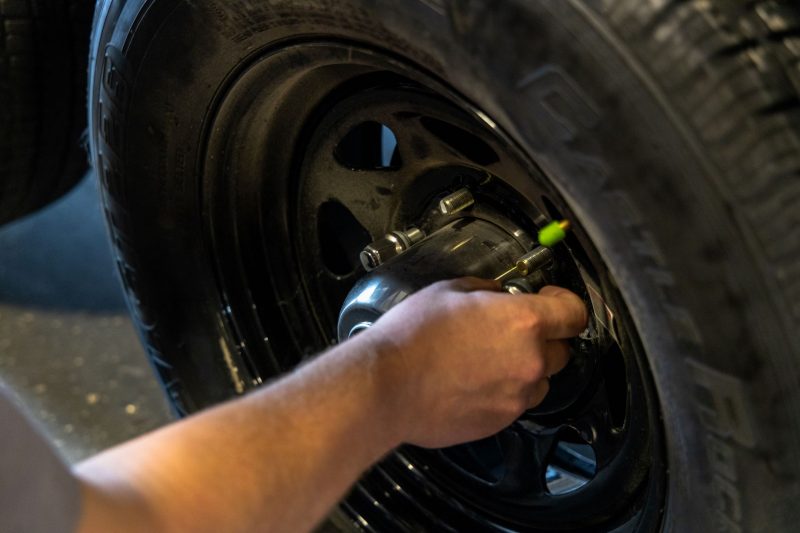
RV tires naturally lose some air during the winter months sitting in storage. The RV owner’s manual has the recommended PSI based on the load of the RV. Correct the pressure of your tires and examine the tread. If your RV was sitting for an extended period of time on dirt, grass or asphalt without blocks you could risk having flat spots on your tires. Vibration, difficulty handling, or a thumping noise while driving indicates that you may have a flat spot and need new tires.
If You Have A Motorhome, Check The Engine
Checking your motorhome’s engine is very important when dewinterizing. Check your engine’s fluid levels like oil, coolant, transmission fluid, power steering fluid and windshield washer fluid. If you have a diesel engine, check your Diesel Exhaust Fluid (DEF) levels, too.
When you start your RV, be sure to check that no check engine lights are on and all your systems work properly in the cab. If your motorhome’s check engine light comes on or your systems are not working properly, get your motorhome serviced professionally.
Check Your RV’s Battery Condition
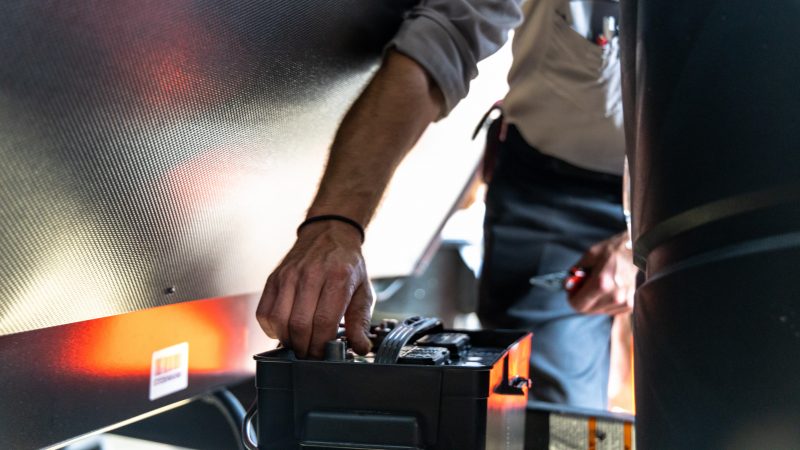
Now it’s time to get your battery hooked back up. RV batteries will lose a bit of charge while in storage. Check the charge on your RV batteries and recharge them if needed. It is important to make sure your battery is not connected to electricity or else you could get an incorrect reading.
Check the RV battery fluid levels as well, adding distilled water to your lead-acid batteries as needed until the battery is properly filled. If you have to fill your battery fluid level, make sure you wear gloves and remove all jewelry. Wearing jewelry while working with electricity can lead to burns if you are not careful.
Inspect Your RV’s Propane System
The next step is to check your RV’s propane system if your RV has one. Double check the hoses and seals for any cracks or damages before you turn on your propane appliances. If your propane system looks good and your tanks are filled, you can turn your system on and check each propane appliance.
If you are checking your RV propane hot water heater, make sure your tanks are flushed of any antifreeze and full of fresh, potable water. Manufacturers warn against having antifreeze in hot water heaters. Antifreeze can harm the anode rod and can be hard to flush out of your hot water heater.
Examine Your RV Generator Or RV Solar Components
Inspect the generator for any debris or corrosion on the exhaust. If the generator looks clean, make sure the oil level is properly filled and you have fuel to run it. If you periodically ran your generator during the winter, it should start without any issues. The oil can sludge, and you can risk the components seizing if you don’t run your RV generator regularly during storage. Give it a few minutes to warm up and then put it under a 50% load for about half an hour.
If you have RV solar panels, snow or hail can crack them in the winter. Make sure the solar panels are free of damage and debris, as well as any bird nests or other small animals that may have taken shelter under the panels. Let your RV solar panels charge fully before turning on any appliances to test your electrical system.
Test Your RV’s Electrical System
Once you have tested all your systems to make sure they are working properly, you should also check your RV’s interior and exterior electrical system. Make sure all your lights work inside and outside, as well as any speakers, awnings and appliances. If you have RV auto leveling jacks or RV hydraulic jacks, test that they are working properly.
You also should check your motorhome or travel trailer’s turn signals, running lights and any other exterior lights for the roadway. If they are not working properly, check the bulb or schedule repairs to diagnose the problem before the camping season and a potential ticket.
If your RV has slideouts, extend them and inspect the interior and exterior for signs of water damage. Make sure your slide seals are in good condition; if you can see light through your RV’s slide seals, you need to replace them. It’s also recommended to lubricate the slides on some RVs. Check your owner’s manual for the manufacturer’s recommended procedures for your RV.
Flush And Sanitize Your RV Water System
Before you flush your RV’s plumbing system, look for any water damage or cracks in the pipes. You also need to double check that your water heater is still in bypass mode.
Flush Your RV Water System
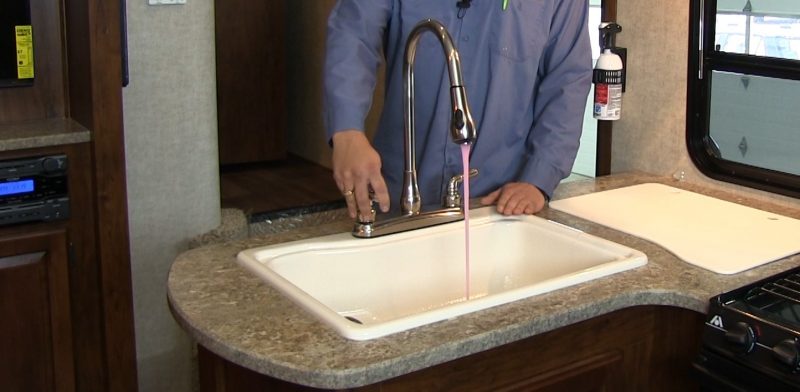
There are two ways you can dewinterize your system: through the water tank or city water connection. To fill from the tank, fill water into your freshwater holding tank and turn on the water pump. If you are flushing your system through the city water connection, a garden hose works well to flush the system. Some RVs have low-point drains that you can open. You can use these valves to help the antifreeze run out of the pipes.
The next step is to run each fixture one by one, turning hot and cold on separately. Run each interior faucet and any outside shower, kitchen, or other various water sources. You should also flush the toilet a few times. Most RV antifreeze is pink in color and bubbles, indicating that antifreeze is still present. When no bubbles are present and the water is clear, the line is clean of antifreeze.
Washing machines, dishwashers and icemakers have special dewinterizing instructions. Check the owner’s manual carefully or seek professional service if applicable to your RV.
Then properly dispose of the antifreeze and empty your black and grey water tanks.
Sanitize Your RV Water System
The second step to dewinterizing your RV water system is to sanitize it. Sanitizing your water system removes bacteria from your lines that might be growing from sitting over the winter months. Double check your owner’s manual if you are able to sanitize your hot water heater as well. Some brands allow for sanitization while others can become damaged. If you cannot sanitize your water heater, leave your drain plug out and water heater in bypass mode until you are done.
Use ¼ cup bleach for every 15 gallons of water your fresh water tank holds. Fill the fresh water tank with the mixture and make sure the tank is full.
Turn on your RV water pump and turn on each faucet until you can smell the bleach mixture. It may take a couple minutes at first for the mixture to come through the lines. Then close the faucets and let the solution sit for a minimum of three hours. You can leave the sanitizing solution in the water lines for up to 12 hours.
Once the mixture has sat, it’s time to drain the system and refill with fresh water. Flush the system again until you no longer smell the bleach and all the water is flushed out.
Don’t forget to put your drain plug back in for the hot water heater. Once you are done sanitizing, you have successfully made your RV’s water system ready for camping!
Replace RV Filters and Safety Devices
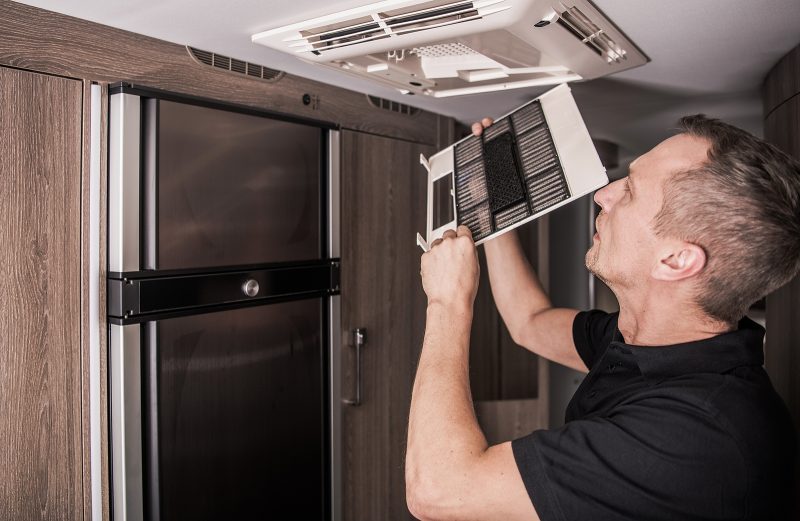
After flushing and sanitizing your RV’s plumbing system, it’s time to replace your water filters. Water filters need to be replaced every three to six months depending on use and brand. This will also ensure that your water does not have a lingering taste from the sanitization.
Check the air filters to see if they need to be replaced too. Air filters are necessary for flowing clean and cool air throughout your RV. If you don’t regularly clean the filters, they can start to draw more energy, reduce airflow and damage your AC system if left unaddressed for too long. Some RV air filters can be washed, while others need to be replaced. Check your owner’s manual to see your requirements.
Since you are already preparing your RV for the camping season, safety devices are another important thing to check. Put in fresh batteries and test the smoke detectors, LP detector and carbon monoxide detector. Also, check the fire extinguisher’s expiration date and replace it if needed.
Clean Your RV Before Your First Trip
Next, do a little spring cleaning to get your RV ready for the camping season. Wash and wax your RV thoroughly. Extend your awning and wash the top and bottom. Awnings are prone to mildew, so airing it out after a good cleaning will protect from unwanted moisture. Lubricating your awning arms is also a good idea to protect it from malfunctioning and becoming stuck.
Clean your window screens for better airflow and check that there are no holes for bugs to creep into. Dusting around your RV, vacuuming and sweeping are other good spring cleaning tasks. This way you have no cobwebs or debris in your RV before your first trip. If you left your bedding and towels in the RV, spring cleaning is also a great time to refresh your linens before your first adventure.
A good tip for when you are getting ready for camping season is to check your gear! Grills, camping chairs and other essentials you store in the RV might need to be replaced. Make sure everything is still in good condition. Nothing is worse than a broken camping chair you forgot to replace. This is a good practice to do before going on any camping trip, but taking note of the gear you need will help you feel more prepared for your first trip ahead of time.
Get Your Dewinterization Done Professionally
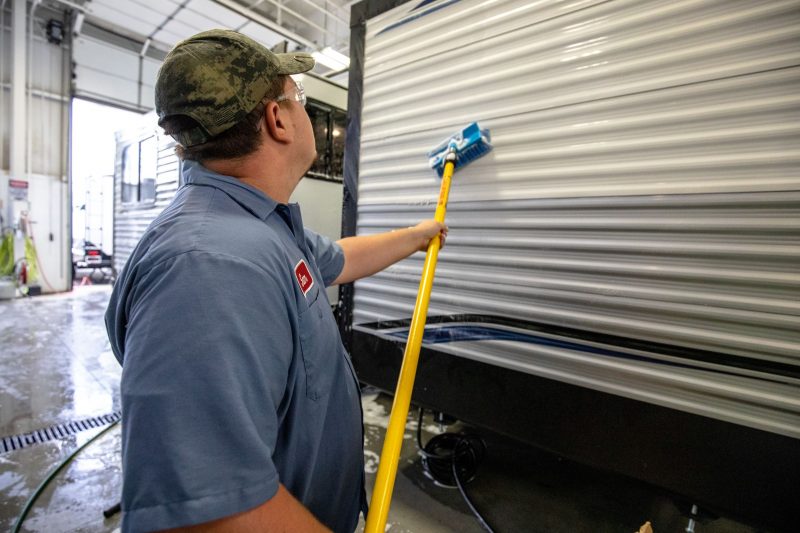
Getting your RV dewinterized by an RV dealership is time saving and hassle-free. They can also look over your RV for any issues while you’re there. By scheduling regular maintenance with your dewinterization, you can have peace of mind that you’ll be ready for the camping season.
Regular maintenance can include a multipoint inspection, where they will look over everything from wheel to roof, making sure your RV is ready for the open road. They can also test for leaks if you notice your seals or caulk are cracked.
Travel trailers also require wheel bearing repacking every year or every 12,000 miles depending on how much you travel. This regular maintenance will help keep you from experiencing towing issues and a potential tire blowout.
When getting your RV dewinterized professionally, you can also get a roof wash and treatment to properly seal your roof for the camping season. RV experts will seal your roof to help prevent harsh summer weather from harming your roof.
All Systems Go For Camping Season
Now that you have dewinterized your RV, you are ready to hit the road! Just remember, all RVs are different and it is best to consult the owner’s manual or seek professional service if you have any issues.
Find your nearest General RV dealer if you want to learn more about having your RV professionally dewinterized. With over 500 service bays across our 14 locations, having your RV serviced for the camping season is easy.